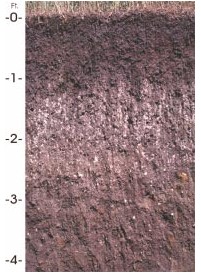Classification and Genesis
Houdek topsoil is composed of weathered glacial till and 2% to 4% organic matter which gives it a deep, dark color. The slopes ranges from 0 to 25 percent depending on location. [3] The subsoil consists of layers of clay and lime accumulations that were carried downward from the surface by water. Below these layers is the parent material called glacial till. The family name is fine-loamy, mixed, superactive, mesic Typic Argiustoll. [3]
The Houdek soil series is deep, well drained, loamy soil that represents many soils formed in South Dakota under grass vegetation. The dark color of the surface layer is a result of decomposition of biomass from vegetation and other materials that have been deposited over thousands of years. [1] Prairie conditions form a thick, dark colored, humified surface horizon or layer that is humus rich (1 to 4% organic C). This is a key characteristic that makes these soils fertile. [4]
Characteristics: The depth to carbonates ranges from 14 to 24 inches. Thickness of the mollic epipedon ranges from 8 to 20 inches and includes all or part of the Bt horizon. The soil contains 0 to 10 percent by volume of coarse fragments as pebbles. Some pedons contain up to 20 percent by volume of stones throughout. [3]
The A horizon has hue of 10YR, value of 3 to 5 and 2 or 3 moist, and chroma of 1 or 2. It typically is loam or silt loam but is clay loam in some pedons. It is slightly acid or neutral. [3]
1) Clay accumulation layer
The Bt horizon has hue of 10YR or 2.5Y, value of 4 to 6 and 3 to 5 moist, and chroma of 2 or 3. It is clay loam averaging between 27 and 35 percent clay. Some pedons have thin horizons that exceed 35 percent clay. It is neutral or slightly alkaline. [3]
2) Lime accumulation layer. As the Houdek soils weathered and formed, water from the soil surface carried lime and clay downward. These materials were deposited deeper, forming the two subsoil layers. [1]
The Bk horizon has hue of 10YR or 2.5Y, value of 4 to 6 and 4 or 5 moist, and chroma of 2 to 4. It is clay loam or loam and is slightly or moderately alkaline. It contains few to many, fine or medium accumulations of carbonate. [3]
The last layer in the Houdek soil is the parent material. This layer represents the materials from which the Houdek soil has developed with time. It represents what the glacier originally left at the soil surface. Climate factors and vegetation/soil organisms have weathered the glacial parent materials to form the present day Houdek soil. [1]
The C horizon has hue of 10YR, 2.5Y, or 5Y, value of 5 to 7 and 4 to 6, and chroma of 2 to 4. It is loam or clay loam and is slightly or moderately alkaline. It has few to many mottles inherent to the parent till. It has few or common accumulations of gypsum between depths of 40 and 60 inches in most pedons. [3]
The classic Houdek soil profile includes: a 6-8 inch friable, neutral, black loam topsoil; a 10 to 15 inch friable, neutral, dark brown clay loam subsoil; a 15 to 30 inch friable, calcareous, moderately alkaline, olive brown clay loam subsoil; and 20+ inches of friable, light olive brown, calcareous, moderately alkaline clay loam parent material. [1]
Climate and Vegetation
The average annual air temperature is about 48 degrees F and the average annual precipitation is 22 inches. [1] Due to its high storage of water that is plant available no irrigation is needed during the growing season to sustain at least three months of perennial grasses ranging from tall, mid, or short species. The amount of precipitation is sufficient to provide good production of organic residues but not enough to cause severe weathering and leaching. [4] The climate and vegetation have interacted in South Dakota to produce seven major soil regions. These regions are named: Cool Moist Forest; Cool, Very Dry Plain; Warm, Very Dry Plain; Cool Dry Plain; Warm Dry Plain; Cool Moist Prairie; and Warm Moist Prairie. [2]
Houdek soils are recognized for their uses for cropland and rangeland. Common crops grown are small grains, sunflowers, corn and soybeans are commonly grown crops. Livestock graze pastures of Alfalfa and other native grasses. Large areas of Houdek soils are also composed of native range. Crops and grasses grown on the Houdek soil also provide habitat for wildlife. Some native vegetation consist of big bluestem, little bluestem, western wheatgrass, green needlegrass, needle and thread, sideoats grama, blue grama, sedges, and forbs. [3]
Economic Importance
The Houdek soil is of major economic importance to South Dakota because it is often used as to grow small grain, corn, sunflowers, and soybeans. [3] South Dakota is well known as an agricultural state with an area of 77, 047 square miles and it has a population density of nine persons per square mile. Cash receipts from farming and ranching normally exceeds $3 billion each year. [1] On the average, South Dakota is recognized nationally in the top ten for corn, soybeans, spring wheat, oat, alfalfa hay, all hay, grain sorghum, sunflower seed, barley, rye, and flaxseed production. [1] With such soil fertile soil comes premium forage for livestock which is why South Dakota also comes in top ten for beef, sheep, hog, and honey production. [1] Houdek loam soil is the foundation of life and the economic base for South Dakota. Houdek loam is a symbol that can help increase public awareness and importance of South Dakota's soil resources. [1]
